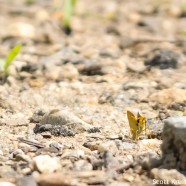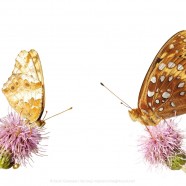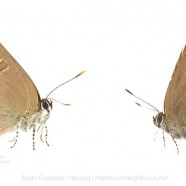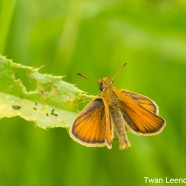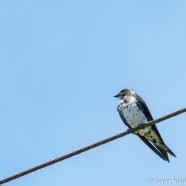Delaware Skipper
This skipper was very jumpy and difficult to photograph even at a considerable distance! It is a Delaware Skipper (Anatrytone logan) butterfly, and it was enjoying this plot of soil, rocks and emerging vegetation. Sometimes one is reminded why they call them “skippers”…
Read MoreVariegated & Great Spangled Fritillaries
Here’s a beautiful close-winged view of the Variegated Fritillary (Euptoieta claudia) and Great Spangled Fritillary (Speyeria cybele). Photographed by RTPI Affiliate Sean Graesser for the Meet Your Neighbours global biodiversity project in Connecticut while on assignment for the Roger Tory Peterson Institute of Natural History.
Read MoreBanded vs. Hickory Hairstreaks
It’s been a great year so far for the Banded Hairstreak (Satyrium calanus) says Sean. He can typically walk around right now in favorable areas and find four or five. Recently while out walking at Audubon Greenwich he spotted a Hickory Hairstreak (Satyrium caryaevorus), a difficult hairstreak to find and get a confident identification of in Connecticut. He put together a comparison of the two to help with some of the small diagnostic differences. Photographed by RTPI Affiliate Sean Graesser for the Meet Your Neighbours global biodiversity project in Connecticut while on assignment for...
Read MoreEuropean Skipper
This was one of an abundance of European Skippers (Thymelicus lineola) that Twan recently noted while conducting some field work, hopefully the first of many actual native skipper species that will be emerging in our lands soon. The European Skipper has only been on our continent for about a century after its accidental introduction. They are still expanding their range. I wonder if the fact they come out so early in comparison to some other skippers helps them survive, as is the case with many non-native and/or invasive plants that have success here. Scott Kruitbosch Conservation &...
Read MorePurple Martin Wire
There are precious few moments for Purple Martins (Progne subis) to rest at this time of the year with so many hungry mouths to feed back at their gourd. All of the cool butterflies and dragonflies that we regularly post are prey for these birds, and if you visit an especially populated gourd colony you will end up finding parts of them on the ground underneath. They used to be billed as mosquito eaters to help sell those apartments (ain’t marketing grand?) but the Purple Martin relies on much larger prey. If you ever have the chance to watch them feeding their young be prepared for...
Read More



